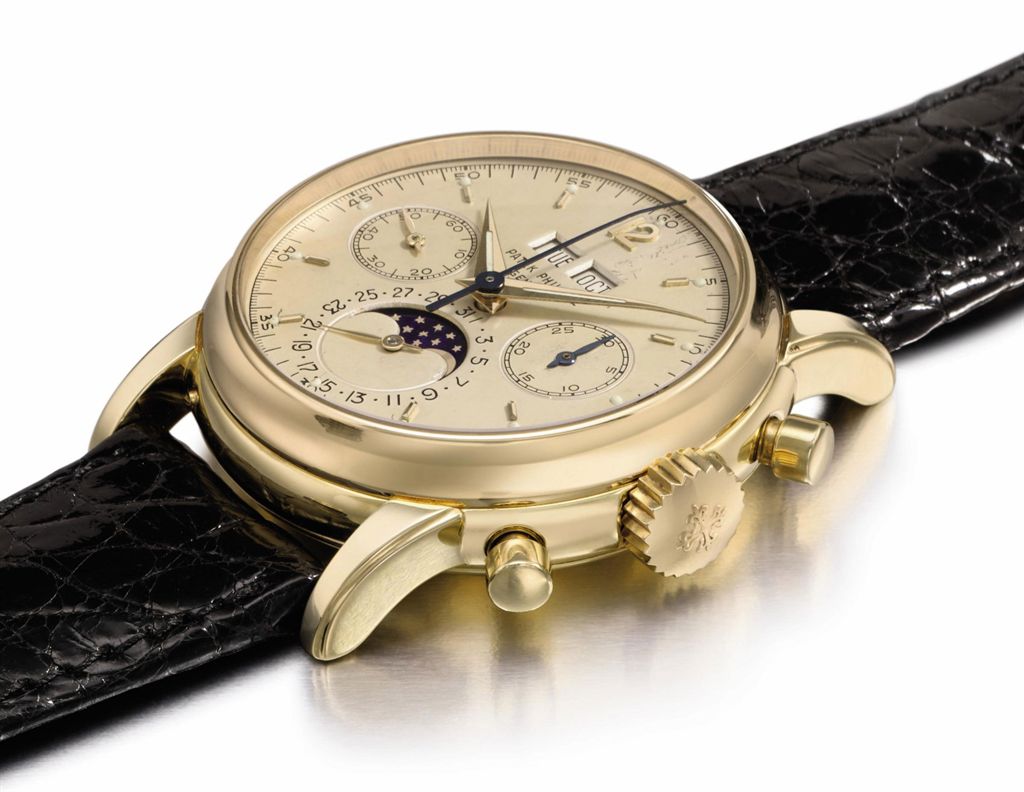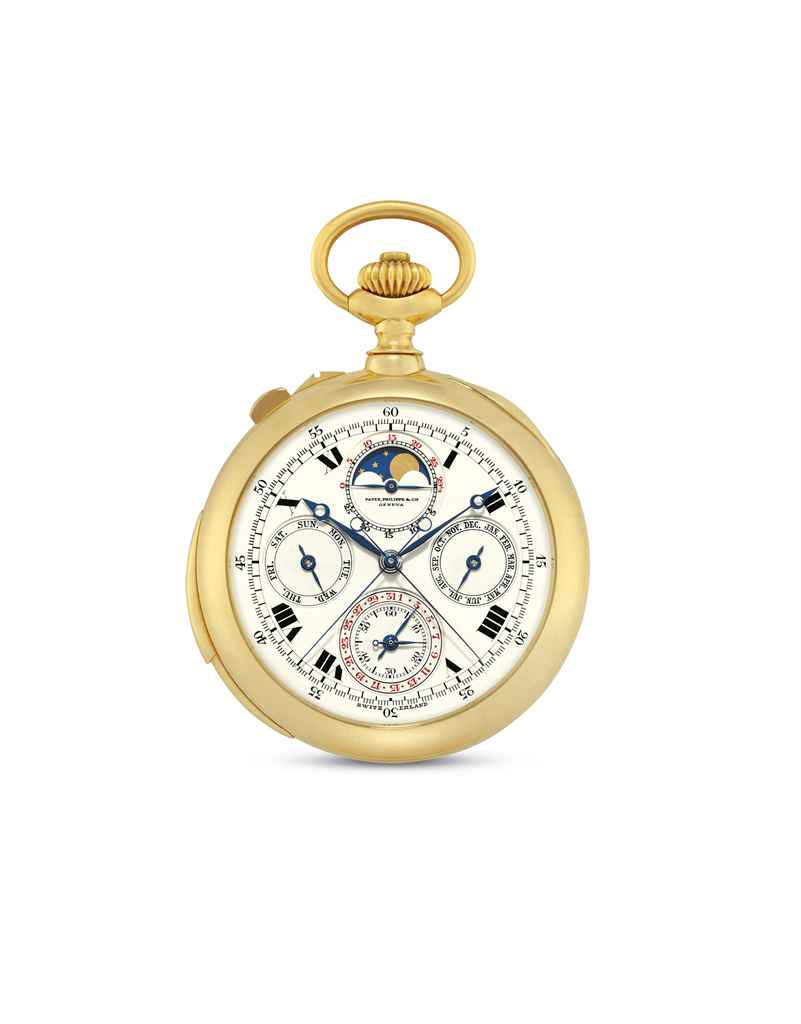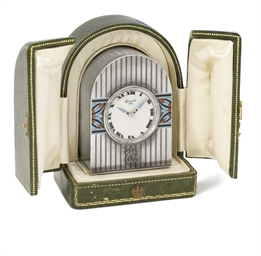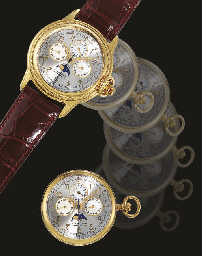Very Fine and Rare Chippendale Carved And Figured Mahogany Tall Case ClockClock Works by Frederick Maus (active 1785 - 1793), Case attributed to George Pickering (d. 1784)Philadelphia, PennsylvaniaCirca 1785
Appears to retain its original finials and rooster cartouche. Dial inscribed Fredk Maus. Philadelphia. Retains a dark possibly original surface.
Height 105 1/4 in. by Width 22 3/4 in. by Depth 11 3/4 in.Condition reportFor further information on the condition of this lot please contact americana@sothebys.com ProvenanceJames Curran Collection;
Samuel T. Freeman & Co., Philadelphia, The James Curran Collection: Rare Eighteenth Century American Furniture, March 11-12, 1940, lot 102.LiteratureJoe Kindig Antiques advertisement, The Magazine Antiques (January 2008).
Albert Sack, Fine Points of Furniture (New York: Crown Publishers, 1950), p. 121.Catalogue noteThis clock is in remarkable condition, retaining its original finish, exceptional rooster finial, and brass waist door escutcheon. It has been illustrated by Albert Sack in Fine Points of Furniture as “best” and “a most important example of the Philadelphia school” with a rooster finial that “is the proud achievement of a master carver.” Rare on American clocks of the 18th century, the rooster finial symbolized Apostle Peter, the patron saint of clock- and watchmakers. In Luke 22:34 of the King James version of the Bible, Christ predicted during the Last Supper: “I tell thee, Peter, the cock shall not crow this day, before that thou shalt thrice deny that though knowest me.” After this prediction came true with the arrest and trial of Christ, a penitent Peter wept after hearing the cock’s crow. Peter became symbolized by the cock and because it reliably crowed on schedule, he was an appropriate patron saint of clockmakers.1The movement was made by Frederick Maus, a clockmaker who was working in Philadelphia by 1782 when he advertised in The Pennsylvania Packet to circa 1810, when he moved to Hilltown, Pennsylvania.2 He was the son of the clockmaker, Jacob Maus, of Philadelphia who worked from 1780 in Trenton, New Jersey on the corner of Broad and State Streets, later on Warren Street. Frederick worked during his time in Philadelphia at 194 North Second Street between Vine and Cahill and Brown’s Alley between Third and Fourth Streets.
The case is attributed to the Philadelphia cabinetmaker, George Pickering (died 1784). A closely related case with a rooster finial is found on a tall case clock labeled by George Pickering that sold in These Rooms, Masterpieces from the Time Museum, Part II, June 19, 2002, sale 7816, lot 139 for $532,000, setting a world auction record at the time for the Philadelphia form. A tall case clock at the Philadelphia Museum of Art (accession number 1998-81-1) with a movement made by Frederick Dominick (died 1811) is housed in a virtually identical case that is attributed to Pickering.3
George Pickering trained at least two apprentices, Thomas Heber in 1771 and William Hines in 1772. In 1775, he and the cabinetmaker Thomas Bryan (d. 1799) ended their partnership. After Pickering’s death in 1784, the cabinetmakers William Rigby (d. 1796) and Jonathan Gostelowe (1744-1795) appraised his estate on December 31st of that year listing veneers, 109 feet of mahogany planks, 125 feet of walnut, finished and unfinished mahogany and walnut furniture, walnut chair feet, carving tools, “chizzels.” Gouges, pincers, numerous planes, “All the Patterns,” and 40 Feet of Walnut … for a Clock case.”4
Three other tall case clocks with nearly identical eight-day movements by Frederick Maus appear to stem from the same cabinet shop. All have a case with a scrolled pediment, carved rosettes, solid scrolls boards centering a cylindrical plinth, dentil molding, colonnettes, quarter columns, and bracket feet. One example also with a rooster finial is in the collection of The Detroit Institute of Arts (accession number 44.44) and pictured in William Distin and Robert Bishop, The American Clock (New York: Bonanza Books, 1976): no. 62, 62a, p. 40. Another with a partially restored rooster finial is in the collection of Independence Hall & The National Park Service.5 The third example is illustrated in a C.L. Prickett advertisement in The Magazine Antiques (May 1990) and also in James Whisker, Pennsylvania Clockmakers and Watchmakers (Cranbury, NJ: Adams Brown, Co., 1990): figure 37, p. 173. A similar case with a rooster finial, replaced movement and dial signed by John Riley was sold at Sotheby’s, Important Americana, January 1991, lot 1431. 1 Hope B. Werness, The Continuum Encyclopedia of Animal Symbolism in Art (New York, 2003): p. 91.2 The Pennsylvania Packet, September 12, 1782 published in The Clock & Watchmakers American Advertiser, 1707-1800 (Ticehurst, UK: Antiquarian Horological Society, 2003) by J. Carter Harris. See also information on Frederick Maus in Chris Bailey, Thomas Spittler, and Sonya Spittler, American Clockmakers & Watchmakers (Arlington Book Company, 2000).3 See Alexandra Kirtley, “Philadelphia Stories,” The Magazine Antiques (January 7, 2019).4 Ibid.5 The clock was restored by Robert Whitley of Bucks County, PA who restored other pieces in the Independence Hall & National Park Service Collection.
Very Fine and Rare Chippendale Carved And Figured Mahogany Tall Case ClockClock Works by Frederick Maus (active 1785 - 1793), Case attributed to George Pickering (d. 1784)Philadelphia, PennsylvaniaCirca 1785
Appears to retain its original finials and rooster cartouche. Dial inscribed Fredk Maus. Philadelphia. Retains a dark possibly original surface.
Height 105 1/4 in. by Width 22 3/4 in. by Depth 11 3/4 in.Condition reportFor further information on the condition of this lot please contact americana@sothebys.com ProvenanceJames Curran Collection;
Samuel T. Freeman & Co., Philadelphia, The James Curran Collection: Rare Eighteenth Century American Furniture, March 11-12, 1940, lot 102.LiteratureJoe Kindig Antiques advertisement, The Magazine Antiques (January 2008).
Albert Sack, Fine Points of Furniture (New York: Crown Publishers, 1950), p. 121.Catalogue noteThis clock is in remarkable condition, retaining its original finish, exceptional rooster finial, and brass waist door escutcheon. It has been illustrated by Albert Sack in Fine Points of Furniture as “best” and “a most important example of the Philadelphia school” with a rooster finial that “is the proud achievement of a master carver.” Rare on American clocks of the 18th century, the rooster finial symbolized Apostle Peter, the patron saint of clock- and watchmakers. In Luke 22:34 of the King James version of the Bible, Christ predicted during the Last Supper: “I tell thee, Peter, the cock shall not crow this day, before that thou shalt thrice deny that though knowest me.” After this prediction came true with the arrest and trial of Christ, a penitent Peter wept after hearing the cock’s crow. Peter became symbolized by the cock and because it reliably crowed on schedule, he was an appropriate patron saint of clockmakers.1The movement was made by Frederick Maus, a clockmaker who was working in Philadelphia by 1782 when he advertised in The Pennsylvania Packet to circa 1810, when he moved to Hilltown, Pennsylvania.2 He was the son of the clockmaker, Jacob Maus, of Philadelphia who worked from 1780 in Trenton, New Jersey on the corner of Broad and State Streets, later on Warren Street. Frederick worked during his time in Philadelphia at 194 North Second Street between Vine and Cahill and Brown’s Alley between Third and Fourth Streets.
The case is attributed to the Philadelphia cabinetmaker, George Pickering (died 1784). A closely related case with a rooster finial is found on a tall case clock labeled by George Pickering that sold in These Rooms, Masterpieces from the Time Museum, Part II, June 19, 2002, sale 7816, lot 139 for $532,000, setting a world auction record at the time for the Philadelphia form. A tall case clock at the Philadelphia Museum of Art (accession number 1998-81-1) with a movement made by Frederick Dominick (died 1811) is housed in a virtually identical case that is attributed to Pickering.3
George Pickering trained at least two apprentices, Thomas Heber in 1771 and William Hines in 1772. In 1775, he and the cabinetmaker Thomas Bryan (d. 1799) ended their partnership. After Pickering’s death in 1784, the cabinetmakers William Rigby (d. 1796) and Jonathan Gostelowe (1744-1795) appraised his estate on December 31st of that year listing veneers, 109 feet of mahogany planks, 125 feet of walnut, finished and unfinished mahogany and walnut furniture, walnut chair feet, carving tools, “chizzels.” Gouges, pincers, numerous planes, “All the Patterns,” and 40 Feet of Walnut … for a Clock case.”4
Three other tall case clocks with nearly identical eight-day movements by Frederick Maus appear to stem from the same cabinet shop. All have a case with a scrolled pediment, carved rosettes, solid scrolls boards centering a cylindrical plinth, dentil molding, colonnettes, quarter columns, and bracket feet. One example also with a rooster finial is in the collection of The Detroit Institute of Arts (accession number 44.44) and pictured in William Distin and Robert Bishop, The American Clock (New York: Bonanza Books, 1976): no. 62, 62a, p. 40. Another with a partially restored rooster finial is in the collection of Independence Hall & The National Park Service.5 The third example is illustrated in a C.L. Prickett advertisement in The Magazine Antiques (May 1990) and also in James Whisker, Pennsylvania Clockmakers and Watchmakers (Cranbury, NJ: Adams Brown, Co., 1990): figure 37, p. 173. A similar case with a rooster finial, replaced movement and dial signed by John Riley was sold at Sotheby’s, Important Americana, January 1991, lot 1431. 1 Hope B. Werness, The Continuum Encyclopedia of Animal Symbolism in Art (New York, 2003): p. 91.2 The Pennsylvania Packet, September 12, 1782 published in The Clock & Watchmakers American Advertiser, 1707-1800 (Ticehurst, UK: Antiquarian Horological Society, 2003) by J. Carter Harris. See also information on Frederick Maus in Chris Bailey, Thomas Spittler, and Sonya Spittler, American Clockmakers & Watchmakers (Arlington Book Company, 2000).3 See Alexandra Kirtley, “Philadelphia Stories,” The Magazine Antiques (January 7, 2019).4 Ibid.5 The clock was restored by Robert Whitley of Bucks County, PA who restored other pieces in the Independence Hall & National Park Service Collection.








.jpg)


.jpg)



Testen Sie LotSearch und seine Premium-Features 7 Tage - ohne Kosten!
Lassen Sie sich automatisch über neue Objekte in kommenden Auktionen benachrichtigen.
Suchauftrag anlegen